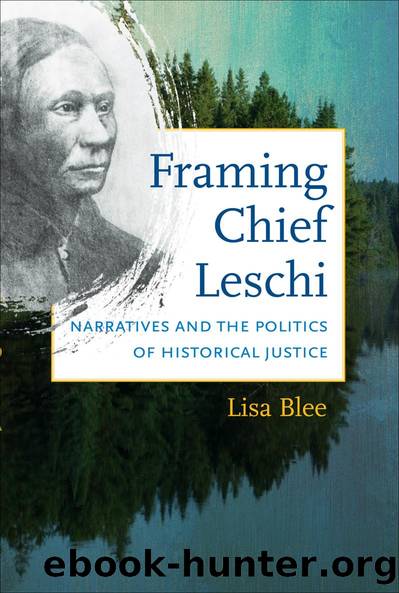Framing Chief Leschi by Lisa Blee

Author:Lisa Blee [Blee, Lisa]
Language: eng
Format: epub
Tags: History, United States, 19th Century, State & Local, Pacific Northwest (OR; WA), Social Science, Ethnic Studies, American, Native American Studies
ISBN: 9781469612843
Google: miaiAgAAQBAJ
Publisher: UNC Press Books
Published: 2014-01-15T04:04:02+00:00
Using the Law?
The petitionersâ legal team recognized that the committee wished to prove Leschiâs innocence but chose to make its case for exoneration based on arguments of law that made the question of Leschiâs part in the alleged murder irrelevant. John Ladenburg, the petitionersâ counsel, informed the petitioners that August Kautzâs map could not serve as the basis for Leschiâs exoneration. A legal case built solely on archival evidence would quickly falter in an adversarial environment; the respondents could easily claim that insufficient evidence remains after 150 years on which to prove or disprove its reliability. This was an astute assessment, for the respondentsâ counsel did make such an argument. Ladenburg thought the petitionersâ case should be built primarily on a legal argument: Leschi was an enemy combatant who should not have stood trial for a killing committed during a time of war.81 The lawyersâ legal performances all but announced that questions of fact (whether Leschi did or did not kill Moses) would be subordinate to questions of law. Yet this was a necessary compromise to counter the respondentsâ claim and establish a convincing case for the judges.
Thus, the petitionersâ legal counsel, not the committee members, articulated an argument that explicitly linked Leschiâs exoneration to tribal sovereignty. Charles Wilkinson testified that the Medicine Creek Treaty acknowledged Nisqually sovereignty and thus militiaman A. B. Mosesâs death was the result of war between nations. Captain Eugene Ham supported Wilkinson with evidence that the army defined the fighting between Nisquallies and U.S. soldiers in 1855 as a war and considered Leschi a lawful combatant. The petitionersâ case rested on the legal assumption of Nisqually nationhood and sovereign right to declare and commence war, and it thus offered a more politically urgent message than the Committee to Exonerate Chief Leschi had planned. Carpenter was convinced that the simple truth was that Leschi had not killed A. B. Moses on Connellâs Prairie in 1855. She later said that tribal sovereignty played no role in her decision to press for Leschiâs exoneration, yet tribal sovereignty was the basis on which the petitionersâ counsel built its legal case and a major consideration in the justicesâ ruling.82
After the closing statements in the Historical Court, the panel of judges had moral, historical, and legal issues to consider: the Native American representatives testified to their knowledge of Leschi and his meaning to them; historians laid out their interpretations of events based on documentary evidence; military lawyers explained how the U.S. Army categorized Leschi at the time and today; and the legal counsel for both sides made their cases based on a defense of the rule of law. The Historical Court had partially revised the historical narrative by presenting this testimony in a public forum, but it was ultimately up to the judges to proclaim what the law (and a moral society by extension) should make of this history.
The justices in the Historical Court could determine the criteria of âfactâ as well as âlawâ to be applied in the case. Technically,
Download
This site does not store any files on its server. We only index and link to content provided by other sites. Please contact the content providers to delete copyright contents if any and email us, we'll remove relevant links or contents immediately.
Cecilia; Or, Memoirs of an Heiress — Volume 1 by Fanny Burney(32440)
Cecilia; Or, Memoirs of an Heiress — Volume 2 by Fanny Burney(31875)
Cecilia; Or, Memoirs of an Heiress — Volume 3 by Fanny Burney(31858)
The Great Music City by Andrea Baker(31539)
We're Going to Need More Wine by Gabrielle Union(18973)
All the Missing Girls by Megan Miranda(15599)
Pimp by Iceberg Slim(14399)
Bombshells: Glamour Girls of a Lifetime by Sullivan Steve(13979)
Talking to Strangers by Malcolm Gladwell(13233)
Norse Mythology by Gaiman Neil(13217)
Fifty Shades Freed by E L James(13163)
For the Love of Europe by Rick Steves(13134)
Mindhunter: Inside the FBI's Elite Serial Crime Unit by John E. Douglas & Mark Olshaker(9212)
Crazy Rich Asians by Kevin Kwan(9174)
The Lost Art of Listening by Michael P. Nichols(7412)
Enlightenment Now: The Case for Reason, Science, Humanism, and Progress by Steven Pinker(7243)
The Four Agreements by Don Miguel Ruiz(6641)
Bad Blood by John Carreyrou(6559)
Weapons of Math Destruction by Cathy O'Neil(6152)
